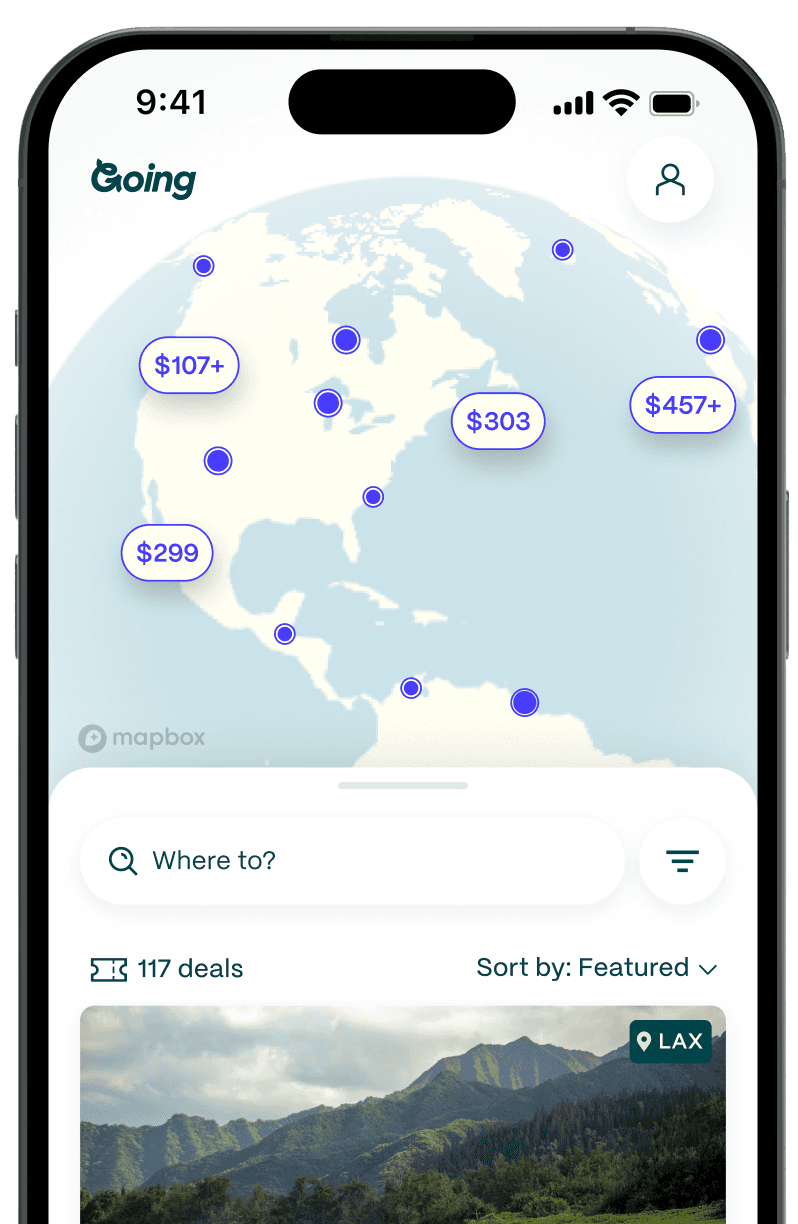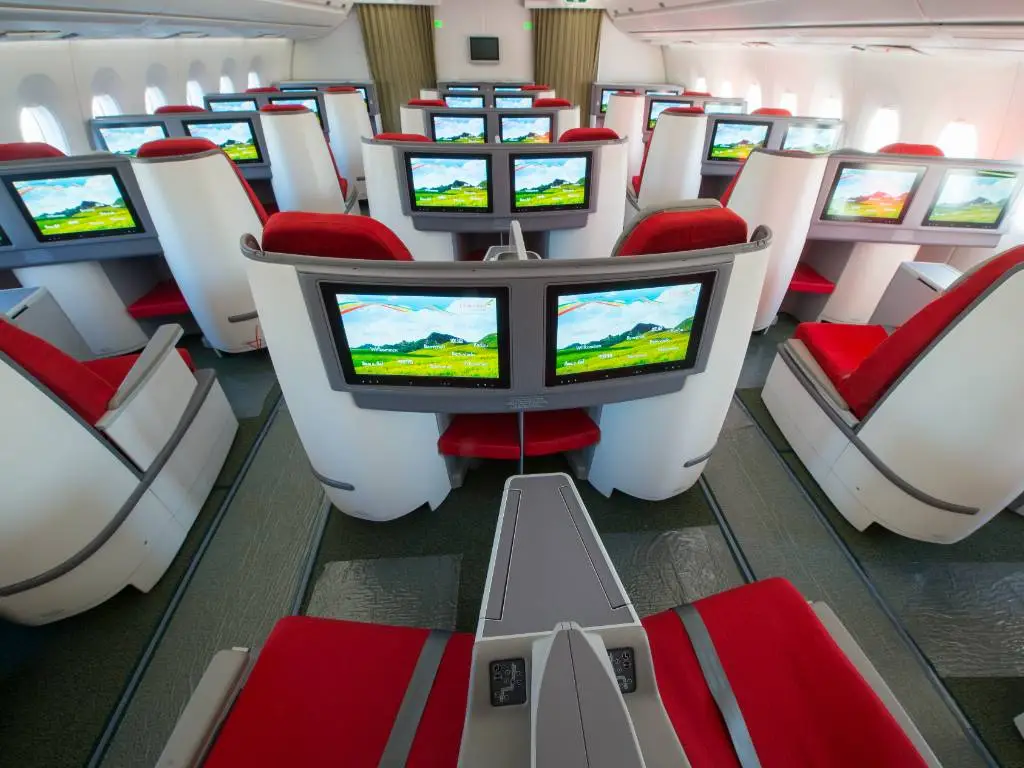
Ethiopian Airlines Business Class Review: Is It Worth the Upgrade?
Table of Contents
Key takeaways
- Founded in 1945, Ethiopian Airlines is Africa's largest aviation group, offering flights to destinations across Africa, Europe, Asia, and the Middle East. It joined Star Alliance in 2011 and was named Africa's best airline in 2021.
- Available on medium- and long-haul routes, Cloud Nine offers a mix of Ethiopian and international cuisine, with amenities like flat beds, entertainment, and Wifi on select flights. Passengers also enjoy a simple amenity kit and excellent wine options.
- Business class passengers have access to the Cloud Nine Lounge in Addis Ababa, with services including free Wifi, showers, Ethiopian coffee ceremonies, and a variety of meals. Expedited check-in and generous baggage allowances are also offered.
- Business class fares typically start from $2,200 for roundtrips to Africa, and upgrades are available through bidding or using ShebaMiles. While upgrades aren't typically free, loyal members may have a better chance.
- With a Going Elite membership, you get access to real-time alerts on premium class seats, including Ethiopian Airlines business class, as soon as prices drop.
Founded in 1945, Ethiopia's flag carrier has grown to be the largest aviation group in Africa in terms of passenger numbers and one of the largest airlines in the world in terms of countries served.
The airline operates direct flights from Chicago, New York, Washington DC, and Toronto to Addis Ababa as well as to a number of capital cities across Africa, Europe, Asia, and the Middle East. The airline joined the Star Alliance in 2011, increasing its reach through codeshares and partnerships. Ethiopian was awarded the title of Africa's best airline in both the 2021 Business Traveller Awards and the 2021 Skytrax World Airline Awards.
Going Experts’ Ethiopian Airlines Business Class Review & Score
Ethiopian Airlines Business Class, also known as Cloud Nine, delivers a comfortable and culturally rich experience, but whether it truly feels premium depends on the aircraft and route. On long-haul flights, particularly on the Airbus A350-900, the lie-flat seats, attentive service, and Ethiopian-inspired dining make for an enjoyable journey. However, on shorter routes or older aircraft like the Boeing 737, the experience feels closer to a premium economy upgrade, with less privacy and fewer high-end amenities.
On long-haul flights, the fully flat seats on the A350 are a game changer. They’re spacious, well-padded, and comfortable for overnight travel, though the 2-2-2 configuration means not everyone gets direct aisle access. The dining experience is unique, with Ethiopian dishes like injera and wot alongside international options. While the food is generally flavorful, meal service can feel slow at times, depending on the crew.
Lounge access is a highlight, especially at Addis Ababa’s Cloud Nine Lounge, where passengers can enjoy a full buffet, private seating, and traditional Ethiopian coffee ceremonies. At other airports, though, business class passengers often rely on partner lounges, which can be hit or miss.
That being said, not all Cloud Nine experiences feel equally premium. While the A350 delivers a solid business class experience, the older 737s with recliner-style seats don’t quite measure up to what other international carriers offer. Service can also be inconsistent, with some flights offering exceptionally warm and attentive crews, while others feel more rushed.
If you’re flying long-haul on the A350, Ethiopian Airlines Business Class is a comfortable and enjoyable way to travel, with a few standout perks. But on shorter routes, the premium price tag may not always be justified.
Expert Score: ⭐7/10
What to know about Ethiopian Airlines business class
Ethiopian Airlines’ business class, known as Cloud Nine, is available on medium- and long-haul routes. Ethiopian Airlines business class food options highlight both Ethiopian and international cuisine, with some of the Horn of Africa's most celebrated fare—including coffee and the fermented staple bread injera—offered on board.
While a basic version of Cloud Nine is available on many domestic flights across Ethiopia, this guide focuses primarily on the services found on medium- and long-haul flights. While there are many consistencies found across Cloud Nine in Ethiopian’s international fleet, there are a few variations, primarily when it comes to seating arrangements. Here's what you need to know about flying business class on Ethiopian Airlines.
Examples of business class fares on Ethiopian Airlines found by Going
- South Africa for $2,674 roundtrip
- Kenya for $2,318 roundtrip
- Namibia for $2,888 roundtrip
- Maldives for $2,550 roundtrip
The Ethiopian Airlines business class experience at the airport
Ethiopian Airlines business class lounge

Business class travelers have access to the Cloud Nine Lounge in Terminal 2 of Addis Ababa (ADD) and can use Star Alliance partner lounges around the world. The Cloud Nine lounge offers free Wi-Fi, showers, plush chairs, and a buffet service at lunch and dinner, with plenty of global and Ethiopian dishes to try. Snacks and beverages, including wine and liquor, are available both during and outside of meal times.
Other features include luggage storage, a kids' corner, a prayer room, and meeting and business spaces. Guests can also join in on a traditional Ethiopian coffee ceremony right in the lounge. Note that if you are changing flights in Addis Ababa, you can only use the lounge if your outbound flight is also in business class.
Want to get the best flight deals? Discover expert tips on how to find cheap flights and save big on your next trip.
Check-in
Business passengers get expedited check-in, with dedicated counters, though you can speed things up even more by entering passport details and any other additional required information online, before you head to the airport. Some airports also offer priority security lanes for business class travelers.
Baggage allowance
Cloud Nine business class passengers enjoy generous checked baggage allowances, and three pieces weighing no more than 23 kg (50 lbs) each is standard across international routes, compared to only two pieces for economy passengers. Passengers on flights to and from the USA can opt to instead check two pieces weighing no more than 32 kg (70 lbs) each. An additional piece of luggage can be checked free for ShebaMiles Gold and Silver members and Star Alliance Gold Members, though weight limits vary. The airline also offers excess baggage awards, allowing ShebaMiles members to redeem miles to pay for additional baggage.
Note that codeshares in which the first segment is operated by a partner airline follow partner airline baggage allowance rules. In addition, C9 passengers may carry up to two pieces weighing no more than 7 kgs (15.4 lbs) each on board. 20x40x55 cm (8x16x22 in).
Need an upgrade fast? Learn how to book last-minute Business Class flights for cheap.
The Ethiopian Airlines business class experience in the air
Ethiopian Airlines business class seats

Airbus A350-900: The Airbus has 30 Cloud Nine seats, configured in a 2-2-2 layout across five rows. These seats lie fully flat and are 22 inches wide, making them the roomiest of the lie-flat options.
Boeing 777-200: This aircraft features a 2-2-2 layout in the first row of Cloud Nine, and a 2-3-2 layout in rows 2 through 5 for a total of 34 seats. These seats are fully lie-flat, but if you are traveling alone and end up in a middle seat, you may have difficulty getting around sleeping neighbors if you need to get up in the middle of the flight.
Boeing 777-300: Cloud Nine in the 777-300 is very similar to what's found in the 777-200, with the first row in a 2-2-2 layout and four additional rows in a 2-3-2 layout. The main difference is that the 34 seats are angle lie-flat as opposed to fully lie-flat.
Boeing 787-8: This plane offers a 2-2-2 layout in Cloud Nine, with four rows for a total of 24 seats, making it the smallest Cloud Nine cabin in Ethiopia’s international fleet. Most seats are fully lie-flat but some aircraft still have the older angled seats.
Boeing 767-300: Ethiopian’s 767-300 originally had recliner seats, but has since been retrofitted with full lie-flat seats in a 2-2-2 configuration. There are only two of these remaining in the fleet and only one is used for commercial services (the other is used for charters).
Timing is key! Learn when to book a cheap flight to score the lowest fares and maximize your savings.
Ethiopian also offers Cloud Nine on select domestic and shorter intra-African flights. 737-700 and 737-800 have 16 recliner seats in Cloud Nine on a 2-2 configuration, while Cloud Nine seats in the Bombardier Q400 are virtually identical to economy. Note that a handful of domestic Q400s are economy-only.
Benefits of flying Ethiopian Airlines business class

Along with plush blankets, pillows, and over-ear headphones for in-flight use, Ethiopian offers a simple in-flight amenity kit for Cloud Nine travelers, complete with essentials such as earplugs, sleep masks, socks, hand sanitizer, lip balm, hairbrushes, toothpaste, and toothpaste. The toiletry bags have a built-in hook so that you can hang them up instead of setting them on shared surfaces. Wi-Fi is available on select flights, and seats have global power outlets and USB jacks along with personal entertainment screens with ejectable controls.
Meals in Ethiopian Airlines business class
Cloud Nine passengers are served plated meals with canapes, starters, main dishes, cheese-and-fruit plates, and desserts. There's also a soup service at dinner and visitors are invited to try Ethiopia's quintessential dish of injera (fermented flatbread made from teff, a gluten-free grain) and wot a spiced stew before the main service.
While it's a good idea to notify the airline at least 24 hours ahead of your flight of any dietary requirements, both non-vegetarian and vegetarian options are available on board, and most vegetarian items are vegan by default, particularly if you opt for Ethiopian dishes. Iftar meals are also available during Ramadan. Note that pork is not served on any Ethiopian flights.

Alcohol
Ethiopian offers a large selection of beverages on board. The wine selection is particularly impressive, with red, white, and sparkling options available—you may even get the chance to try options produced right in Ethiopia's Rift Valley. Beer and a small selection of liquor and liqueurs are also available on board. Mixer options include ginger ale and other soft drinks, juice, and tonic water, as well as non-alcoholic beverages in flavors such as cinnamon, ginger, and tenadam (fringed rue), a popular flavor in Ethiopia. Drinks are served with kolo, a traditional Ethiopian snack made of roasted barley and often mixed with other roasted pulses.
How to book Ethiopian Airlines business class
How much does it cost for a business class ticket on Ethiopian Airlines?
Several factors affect the Ethiopian Airlines Business Class ticket price, including the time of year and how far in advance you book. Generally, fares are three to four times higher than economy class, with prices from the US to Ethiopia starting in the low $3,000s. However, deals do pop up—we’ve found roundtrip business class fares from the US to Africa as low as $2,200. To get alerts on cheap flights, sign up for Going Elite and never miss a deal.
How to upgrade to business class of Ethiopian Airlines for free
Long gone is the age of free upgrades for most passengers on most airlines, though if you are a loyal ShebaMiles member with platinum status, you'll have more luck getting a free shot at one of the coveted seats up front. If you really want to sit in Cloud Nine, however, your best bet is to either buy or bid on an upgrade or redeem ShebaMiles.
How much does it cost to upgrade to business class on Ethiopian Airlines?
If you want to upgrade to business outright, you'll need to contact the airline and pay any difference in fare. A better, but riskier, bet is to bid for an upgrade. The bidding system helps the airline sell seats that would otherwise risk going empty, and generally opens up reasonably close to the departure date.
When a flight becomes eligible for upgrade bidding, economy class passengers can expect to receive an email inviting them to bid. However, you can also enter your booking reference online to see if your trip is eligible. You’ll then have the chance to submit an offer of how much you are willing to pay for an upgrade. Winners will be notified if their bids have been successful between 50 and 6 hours before departure.Prices vary quite a bit depending on a number of factors, but in general start at around $500-$600 for a long haul one way.
Planning a trip to Africa? Find the best deals on flights to Africa today.
How many miles to upgrade to Ethiopian Airlines business class?
ShebaMiles members flying internationally can upgrade from economy to business class using miles on both one-way and roundtrip tickets and are determined by segment. For example, upgrades from North America to Ethiopia require 90,000 roundtrip (or 45,000 miles for one-way flights), while upgrades from Ethiopia to India will set you back 50,000 ShebaMiles (or 25,000 each way). If you’re flying roundtrip between New York and Delhi with a layover in Addis Ababa, you’ll need to fork over 140,000 miles to upgrade the entire ticket to business. However, you could also upgrade just your outbound segment from New York to Addis for 45,000 ShebaMiles. Note that upgrades are not eligible on award tickets or on codeshares operated by other carriers.
Summary
Ethiopian Airlines’ business class is a great choice for long-haul flights, with full or angle lie-flat seats and a wide variety of food and wine options, and plenty of opportunities to sample quintessentially Ethiopian dishes, both at the Cloud Nine lounge and in the sky. And, being able to transform your seat into a bed may make it worth the expense, particularly if you have a gruelingly long trip ahead of you.
The option to bid for upgrades is also an attractive option if you want the business class experience but can’t quite justify the expense of buying a ticket outright. Cloud Nine is also one of the more affordable business class options out there, whether you’re buying a ticket outright, paying for an upgrade, or using ShebaMiles or Star Alliance partner points. The only drawback is that if you’re traveling alone, you’ll need to be prepared for a seatmate, as none of the configurations offer single seats.

Frequently asked questions about Ethiopian Airlines business class
What does Ethiopian Airlines business class include?
Do you get lounge access with Ethiopian Airlines business class?
Do seats in Ethiopian Airlines business class lie flat?
Is food served in business class on Ethiopian Airlines?
How many checked bags do you get in Ethiopian Airlines business class?
What are the best seats in Ethiopian Airlines business class?
What is the best business class Ethiopian Airlines seat?
Is Ethiopian Airlines part of the Star Alliance?
How much is Ethiopian Airlines business class?
Is Ethiopian Airlines a good airline?
Last updated September 3, 2025
Articles you might like
View All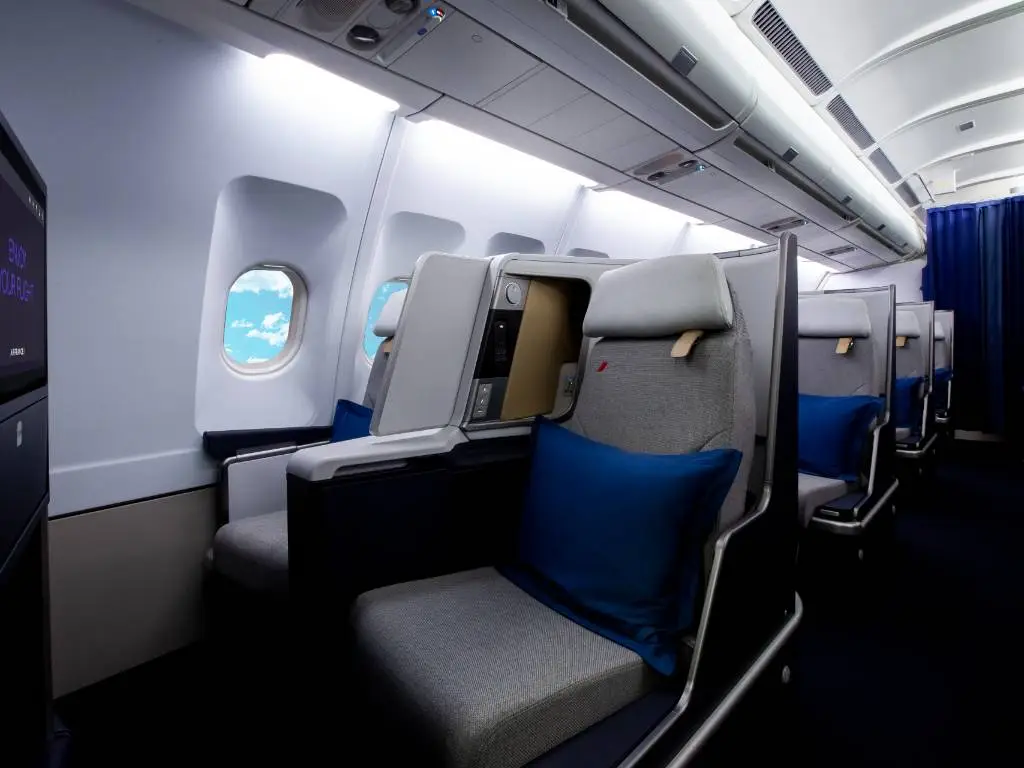
Air France Business Class: My Complete Guide & Experience
Sep 11, 2025
8 min read
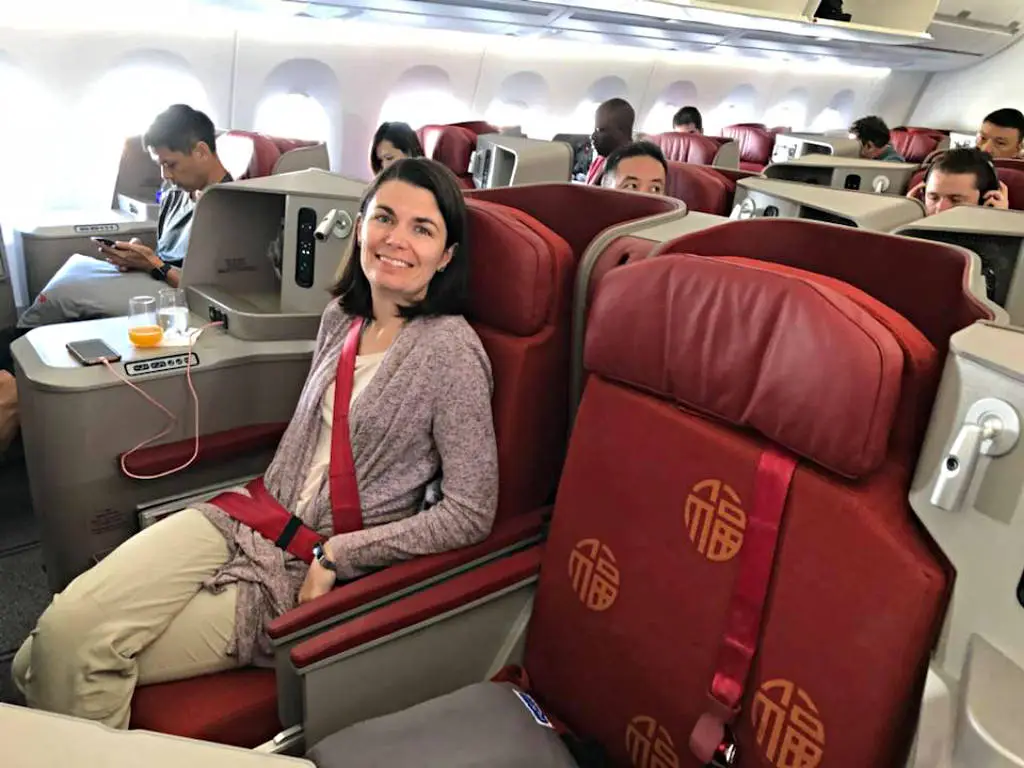
How to Get Business Class Tickets for Cheap (Airlines Hate This)
Sep 11, 2025
3 min read
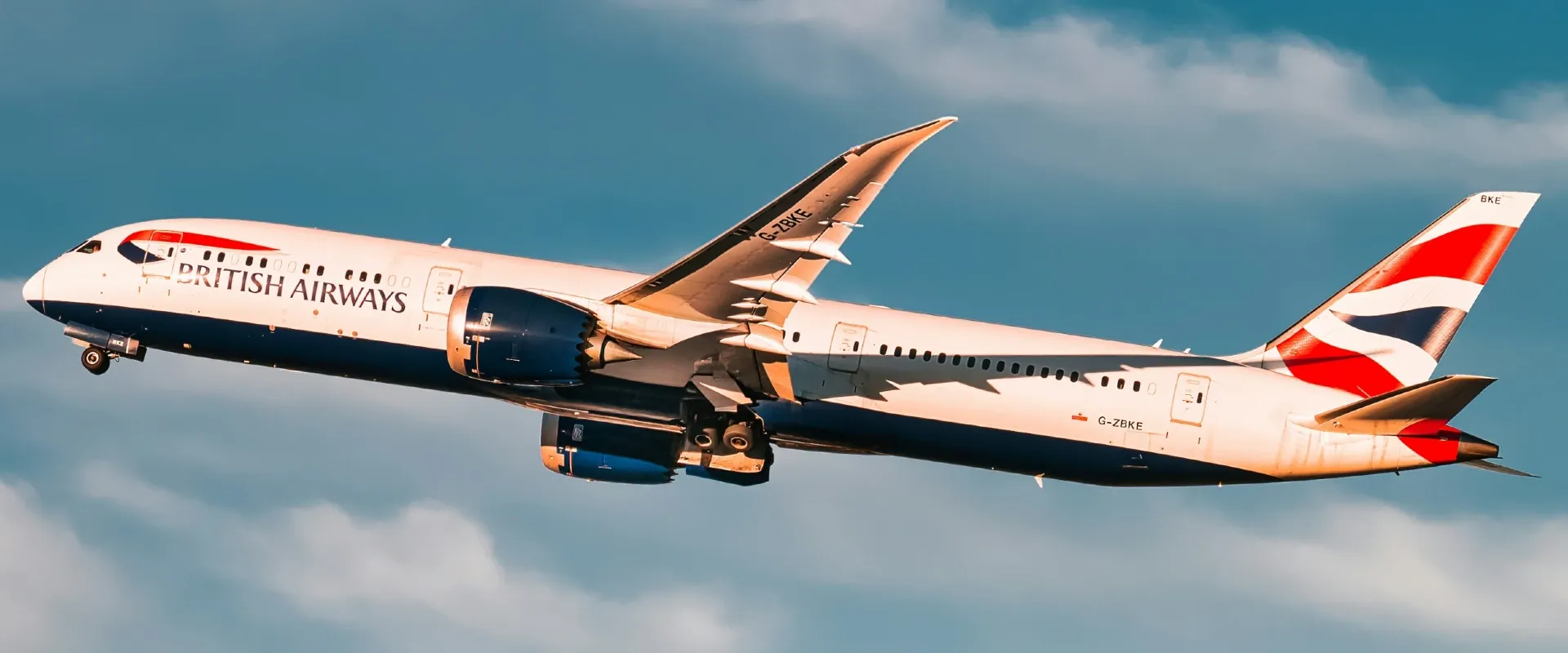
British Airways Premium Economy: Is It Worth Your Money?
Sep 10, 2025
6 min read



